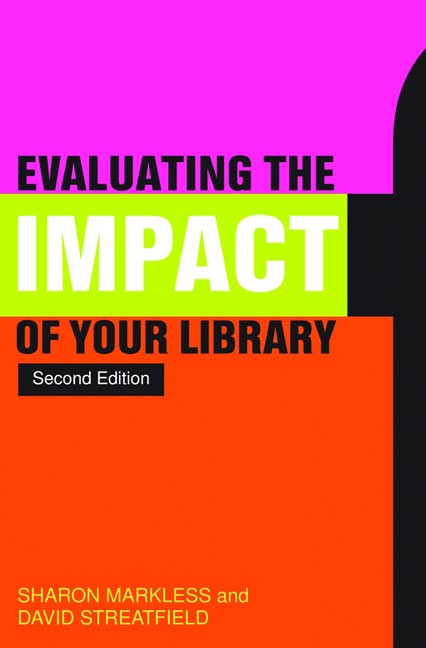Book contents
- Frontmatter
- Dedication
- Contents
- Introduction
- About the authors
- Impact and all that: use of some key terms in this book
- Part 1 The Context
- Part 2 Evaluating Impact
- 4 Putting the impact into planning
- 5 Getting things clear: objectives
- 6 Success criteria and impact indicators: how you know you are making a difference
- 7 Making things happen: activities and process indicators
- 8 Thinking about evidence
- 9 Gathering and interpreting evidence
- 10 Taking stock, setting targets and development planning
- Part 3 The Bigger Picture
- References
- Notes
- Index
- Evaluating and Measuring the Value, Use and Impact of Digital Collections
- Measuring Library Performance
- Miscellaneous Endmatter
8 - Thinking about evidence
from Part 2 - Evaluating Impact
Published online by Cambridge University Press: 08 June 2018
- Frontmatter
- Dedication
- Contents
- Introduction
- About the authors
- Impact and all that: use of some key terms in this book
- Part 1 The Context
- Part 2 Evaluating Impact
- 4 Putting the impact into planning
- 5 Getting things clear: objectives
- 6 Success criteria and impact indicators: how you know you are making a difference
- 7 Making things happen: activities and process indicators
- 8 Thinking about evidence
- 9 Gathering and interpreting evidence
- 10 Taking stock, setting targets and development planning
- Part 3 The Bigger Picture
- References
- Notes
- Index
- Evaluating and Measuring the Value, Use and Impact of Digital Collections
- Measuring Library Performance
- Miscellaneous Endmatter
Summary
If you are working systematically through this section of the book, you have already done much of the main thinking that you need for evidence gathering. Assuming that you have thought clearly about what you are trying to achieve, how you can tell that changes are happening and what will tell you that the changes have happened, you are more than halfway to cracking the problem of gathering evidence. You now need to decide how much evidence to gather.
Deciding your approach to gathering evidence
When people are faced with the prospect of gathering evidence the first reaction is often to panic. How can busy practitioners do the work of professional researchers as well? The answer is that you don't have to. Effective impact evaluation involves careful focus on what is important and then gathering the minimum amount of evidence needed to tell you what you need to know. It should be reassuring to recognize that evidence is not a separate category of information; it is information chosen by someone and gathered for a particular purpose.
The organizational context
The same evidence-collection activities may work in one place and fail somewhere else. When choosing how to gather your evidence, you need to take account of the culture of your organization, current work pressures and how ready your staff are to get involved in this work. Some of the factors to consider are:
Other current or imminent evidence gathering elsewhere in the organization that may compete or conflict with your efforts. (For example, when a university library decides to conduct a survey of part-time and off-campus students it knows that services to these users are a big issue for the university. It suddenly becomes a bigger issue. The governors call for a survey and the central audit team jump straight in with a hurried and poorly designed effort. This produces little of worth, but the library team has to wait for several months for the dust to settle before doing its own survey.)
Timing: what are the best and worst times of day, week, month or year to engage with your target respondents?
Whether your target respondents favour or dislike particular evidence gathering methods. Have they been over-exposed to any particular methods (e.g. are they ‘allergic’ to questionnaires)?
- Type
- Chapter
- Information
- Evaluating the Impact of Your Library , pp. 113 - 126Publisher: FacetPrint publication year: 2012



